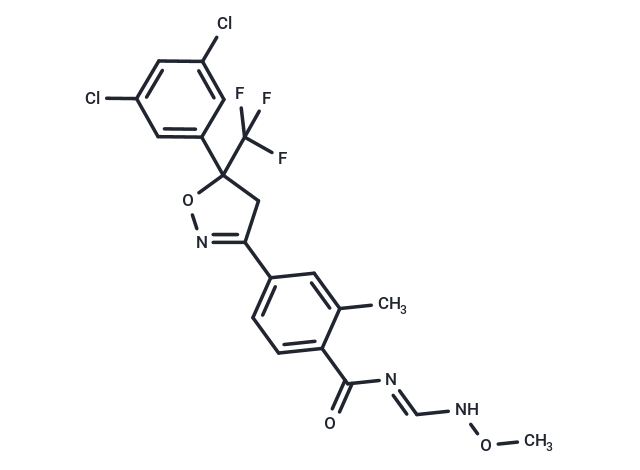Shopping Cart
- Remove All
 Your shopping cart is currently empty
Your shopping cart is currently empty

Fluxametamide is a novel isoxazoline insecticide that acts via distinctive antagonism of insect ligand-gated chloride channels, acts as an antagonist of GABA- and glutamate-gated chloride channels(IC50 of 1.95 nM and 225 nM for M. domestica GABACls and GluCls).

| Pack Size | Price | Availability | Quantity |
|---|---|---|---|
| 1 mg | $32 | In Stock | |
| 5 mg | $73 | In Stock | |
| 10 mg | $123 | In Stock | |
| 25 mg | $263 | In Stock | |
| 50 mg | $428 | In Stock | |
| 100 mg | $662 | In Stock | |
| 1 mL x 10 mM (in DMSO) | $80 | In Stock |
| Description | Fluxametamide is a novel isoxazoline insecticide that acts via distinctive antagonism of insect ligand-gated chloride channels, acts as an antagonist of GABA- and glutamate-gated chloride channels(IC50 of 1.95 nM and 225 nM for M. domestica GABACls and Gl |
| Targets&IC50 | GABACls (M. domestica):1.95 nM , GluCls (M. domestica):225 nM |
| In vitro | Fluxametamide inhibits GABA responses in the wild-type L. striatellus GABACls with IC50 values of 1.40 (0.57-3.29) nM; in the A2′N mutant GABACls, the IC50 value is 3.51 (2.17-5.69) nM. Moreover, Fluxametamide scarcely inhibits GABA (EC50)-induced currents in rat GABACls at 10 μM and with no inhibition on glycine (EC50)-induced current in human α1 GlyCls at tested concentrations.Fluxametamide is an antagonist of GABA- and glutamate-gated chloride channels, dose-dependently inhibits currents induced by GABA and glutamate in M. domestica GABACls and GluCls, with IC50 values of 1.95 (1.18-3.21) nM and 225 (137-372) nM, respectively, and displays potent antagonistic activity against T. urticae GABACls with an IC50 of 0.219 (0.127-0.381) nM. |
| In vivo | Fluxametamide exerts distinctive antagonism of arthropod GABACls by binding to a site different from those for existing antagonists.In contrast to its profound actions on the arthropod LGCCs, the antagonistic activity of fluxametamide against rat GABACls and human glycine-gated chloride channels was nearly insignificant, suggesting that fluxametamide has high target-site selectivity for arthropods over mammals.Overall, fluxametamide is a new type of LGCC antagonist insecticide with excellent safety for mammals at the target-site level. |
| Molecular Weight | 474.26 |
| Formula | C20H16Cl2F3N3O3 |
| Cas No. | 928783-29-3 |
| Smiles | CON\C=N\C(=O)c1ccc(cc1C)C1=NOC(C1)(c1cc(Cl)cc(Cl)c1)C(F)(F)F |
| Relative Density. | 1.43 g/cm3 (Predicted) |
| Storage | Powder: -20°C for 3 years | In solvent: -80°C for 1 year | Shipping with blue ice. | |||||||||||||||||||||||||||||||||||
| Solubility Information | DMSO: 125 mg/mL (263.57 mM), Sonication is recommended. | |||||||||||||||||||||||||||||||||||
Solution Preparation Table | ||||||||||||||||||||||||||||||||||||
DMSO
| ||||||||||||||||||||||||||||||||||||

Copyright © 2015-2024 TargetMol Chemicals Inc. All Rights Reserved.